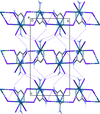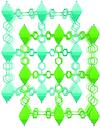issue contents
June 2020 issue

Cover illustration: Asymmetric NO2⋯NO2 interactions are responsible for the assembly of trigonal nets in the structure of 3,5,7-trinitro-1-azaadamantane and are significant for the breaking of inversion symmetry and the generation of supramolecular polarity. See Domasevitch, Senchyk & Krautscheid [Acta Cryst. (2020), C76, 598–604].
research papers
Download citation


Download citation


Open  access
access
 access
accessSmall finite telluride anions are found as dominant species in the anionic layers of modulated LaTe1.82(1), corresponding to its semiconducting properties.
Download citation


Download citation


The crystal structure of the new monoclinic ternary gallide MgCoGa2 has been determined by the single-crystal method. The MgCoGa2 structure type represents the structure family based on YPd2Si and Fe3C.
CCDC reference: 2000059
Download citation


Download citation


Two ZnII-based coordination polymers were prepared by solvothermal synthesis using biphenyl-2,2′,5,5′-tetracarboxylic acid and ZnCl2·4H2O under the control of flexible N-donor ligands. In the structures, the ZnII ions adopt distorted tetrahedral geometries and are bound by tetracarboxylate ligands to produce a two-dimensional layer in one complex and a three-dimensional network in the other. Furthermore, the luminescence properties of the complexes were investigated and the ferroelectric properties of one of the complexes were shown to be a result of its polar point group C2v.
Download citation


Download citation


The role of I⋯N halogen bonding as a driving force to organize the organic solid state to achieve a [2 + 2] cycloaddition reaction is presented. Within the cocrystal, the halogen-bond donor 1,2-diiodoperchlorobenzene is found to π–π stack in a homogeneous and face-to-face pattern, thereby positioning the reactant molecule, trans-1,2-bis(pyridin-4-yl)ethylene, in the correct orientation to undergo a solid-state photoreaction.
CCDC reference: 1947990
Download citation


Download citation


The crystal structures of six halobismuth(III) salts of variously substituted aminopyridinium cations are reported. Discrete mononuclear [BiCl6]3− and dinuclear [Bi2X10]4− anions (X = Cl or Br), and polymeric cis-double-halo-bridged [BinX4n]n− anionic chains (X = Br or I) were observed. The supramolecular networks formed by classic N—H⋯X hydrogen bonds include ladders, bilayers and three-dimensional frameworks.
Download citation


Download citation


In the salt 1-(o-tolyl)biguanidium chloride, a correlation between electrostatic energy and contact enrichment is found only for the strongly attractive (N—H⋯Cl−) and repulsive contacts. Electrostatic energies between moieties reveal that interacting biguanidium cation pairs are repulsive and that the crystal is maintained by attractive cation⋯Cl− dimers.
CCDC reference: 1877569
Download citation


Download citation


Iodination of Ph2Te2Se by molecular iodine is directed towards the Te atom and yields PhTeSeTeI2Ph. The molecule can be considered as a chimera of PhTeSeR, PhTeSeTePh and R′TeI2Ph fragments. The energies of the intermolecular interactions have been calculated and analyzed.
CCDC reference: 1981114
Download citation


Download citation


The ternary bismuthide Li3–x–yInxBi (x ≃ 0.14, y ≃ 0.29) crystallizes in a 2 × 2 × 2 superstructure of the anti-BiF3 type. A delicate interplay between Li/In substitutional disorder and Li deficiency determines the electronic stability of the structure.
CCDC reference: 2003809
Download citation


Download citation


Open  access
access
 access
accessAnisotropic displacement parameters for the isomorphous compounds 1-(halomethyl)-3-nitrobenzene (halo = chloro and bromo) were calculated from first principles and determined by X-ray diffraction experiments. Unexpectedly, the experiment for the bromo compound proved more challenging than theory.
Download citation


Download citation


Asymmetric NO2⋯NO2 interactions are responsible for the assembly of trigonal nets in the structure of 3,5,7-trinitro-1-azaadamantane and are significant for the breaking of inversion symmetry and the generation of supramolecular polarity.
CCDC reference: 2004782
Download citation


Download citation


The tridentate ligand 4,4′,4′′-(4,4,8,8,12,12-hexamethyl-8,12-dihydro-4H-benzo[9,1]quinolizino[3,4,5,6,7-defg]acridine-2,6,10-triyl)tribenzoic acid was characterized together with two coordination polymers with Cd and Zn cores. The photophysical properties of the three compounds were examined by direct measurements and computational models.
Download citation


Download citation


The redox-active CoII atoms of a metal–organic framework (MOF) constructed from 4,4′,4′′,4′′′-(ethene-1,1,2,2-tetrayl)tetrabenzoic acid and 4,4′-bipyridyl as four-point- and two-point-connected nodes, respectively, could be used as the catalytic sites for hydrogen production via water splitting.
CCDC reference: 1992832
Download citation


Download citation


Open  access
access
 access
accessThe FeIIIS2N2O2 chromophore of ammonium bis[salicylaldehyde thiosemicarbazonato(2−)]iron(III) contains two O,N,S-donating salicylaldehyde thiosemicarbazonate(2−) ligands in perpendicular planes, with the O and S atoms in cis and the N atoms in trans positions. The FeIII ion is in the low-spin state at 100 K. Systematic twinning by metric pseudomerohedry is explained by application of the order–disorder (OD) theory.
CCDC reference: 2003812


 journal menu
journal menu






























